

The following article may be used free of charge with no prior authorization provided that it is used for nonprofit purposes and appears with the author biography at the end of this article intact. Please email us with any details of its use so that we can keep the author or other interested parties informed of the use of this article.
Railroad Along the Schoharie:
Prattsville’s Stillborn Railroad
Richard F. Makse
The Delaware & Northern endeared itself to residents of the East Branch valley from Arkville south to the Delaware River as the major means of travel and communication during the first four decades of the 20th century. Founded in 1905 by a New York banker, Frederick Searing, the Delaware & Eastern (the original name of the railroad during the period between 1905 and 1911) was planned as part of a grand scheme to connect anthracite mines in Wilkes-Barre, Lucerne County, Pennsylvania, with commerce in Schenectady, New York. Ground was broken for the new railroad at Dry Brook in Arkville on September 14, 1905.
The core of the D&E was the segment from Arkville south to East Branch. This was opened for full service on November 17, 1906, and provided linkages with the main lines of the Ulster & Delaware Railroad at Arkville and the New York Ontario & Western Railroad at East Branch. The Andes Branch opened for service on March 23, 1907. Searing provided the new railroad with excellent station facilities to handle both passengers and freight.
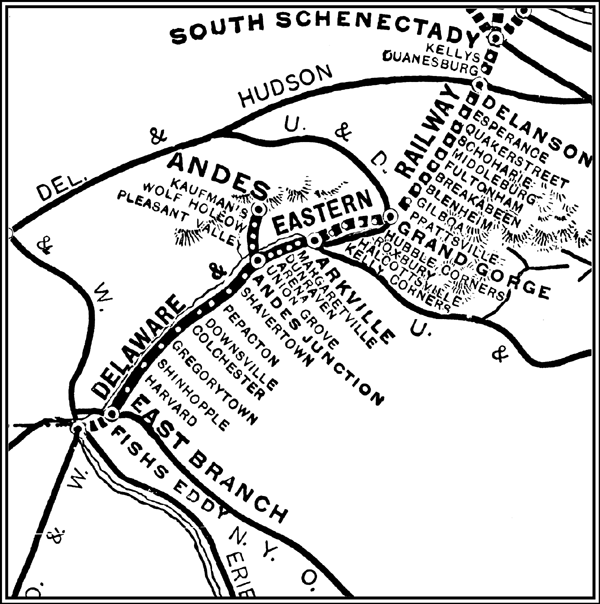 |
Map of the proposed Delaware and Eastern Railway. xxxx(Richard F. Makse Collection) |
Heading Searing’s management team was an experienced railroader, R. B. Williams, a former superintendent of the NYO&W. Under Williams’s competent oversight, the railroad built its own creameries in the East Branch valley between Downsville and Arkville to tap this lucrative dairy market. Farmers heretofore were forced to endure long wagon hauls to the railhead at U&D at Arkville. Williams also tapped local business in bluestone and wood acid from small quarries and plants along the rugged lower part of the railroad between Downsville and East Branch.
In Searing’s Manhattan banking office, grand plans continued for the expansion of the railroad from a rural shortline into a regional coal carrier. The railroad would serve as a conduit for coal and do so more economically than existing lines such as the Delaware & Hudson Railway and the New York Ontario & Western.
Searing lured investors by describing how his new line would eliminate many of the steep grades out of the Lackawanna valley that meant increased costs for labor and materials to haul the “black diamonds.” But court battles with the D&H and the NYO&W temporarily blocked this project until Searing won a favorable court decision late in 1908.
His engineers proceeded with the design of the line from Grand Gorge to Schenectady; Delaware & Eastern trains would operate over the Ulster & Delaware tracks between Arkville and Grand Gorge and over the Middleburgh & Schoharie tracks between Middleburgh and Schoharie Junction. The remainder of the line would be all new construction.
Construction progressed in 1909 and 1910 on the Schenectady Extension with work concentrated in the area between Grand Gorge and Gilboa. The work abruptly halted on February 9, 1910, when Searing’s bank failed because of some bond manipulations by an agent of the bank. With this bank failure, the payroll evaporated and all work ceased on the Schenectady Extension. The railroad would sink into its first bankruptcy and evidence of the plan to reach Schenectady would be scars on the countryside in Delaware and Schoharie counties. In a scant few years, evidence of the grading work north of Prattsville would be obliterated by the construction of the Schoharie Reservoir.
The two major historians of the Delaware & Eastern/Northern, Thomas Archer and Gertrude Fitch Horton, both made ample reference to the construction of the D&E Schenectady Extension (also referred to as the Schenectady & Margaretville Railroad, the name that appeared on stock certificates) in the vicinity of Grand Gorge/Prattsville. While a number of contemporary photos of the grading survive and the nearly 80-year-long existence of the Johnson Hollow Road undergrade bridge provided us with a significant artifact of this work, little research has been done about the precise alignment.
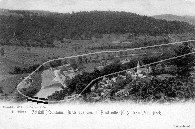 | 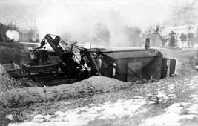 | 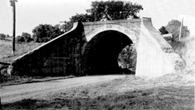 |
| This bird’s-eye view from Pratt’s Rock depicts the horseshoe curve planned by the Delaware & Eastern. Doug Kadow has superimposed the railroad’s alignment on a 1906 Rotograph postcard. Note the curved bridge across Schoharie Creek. The lack of dense forest growth does not hint at the change in grade as the railroad loops around the creek. (Richard F. Makse Collection) | While we are not certain, the terrain suggests that the steam shovel in this view is working Clay Hill behind the Hardenburgh House in the Town of Roxbury. After leaving the cut at Clay Hill, the railroad crossed Bear Kill at Hardenburgh Falls, north of which a short tunnel was planned. (Richard F. Makse Collection) | Railroad fan and photographer Lambert Cook snapped this 1938 view of the bridge over Johnson Hollow Road. The bridge was unceremoniously demolished in 1988 to make it easier for school buses to negotiate the turn off of Route 23. (Steve Delibert Collection) |
During 2005, Doug Kadow, president of the Ulster & Delaware Railroad Historical Society (a regional historical society that runs the Roxbury Depot Museum and is dedicated to the preservation of Catskill Mountain and Hudson Valley railroad history) and your author engaged in new research on the line. Using original railroad surveys and profiles from the county courthouses in Greene and Delaware counties, Doug mapped the alignment through the Prattsville area on contemporary USGS quads. The locations were further confirmed by field observations of the terrain and the use of GPS to confirm the elevations on the D&E’s official profile.
The map on page 7 provides a key to specific locations around Prattsville where tangible evidence of the construction exists. More telling is the concordance of these locations with the route that was mapped by Otto F. Wagenhorst, chief engineer of the Delaware & Eastern.
Much more research remains to be done on the route of the Schenectady Extension. One of the questions to be addressed in the future is the gap of two years between the Greene County and Delaware County route maps. While both maps complement one another, the extant Delaware County map begs the question as to the possible existence of an earlier version that used a separate D&E right-of-way between Arkville and Grand Gorge, pointing to the original stock issuance of the Schenectady & Margaretville.
A careful check of the indices as well as physical maps at Delhi Courthouse failed to locate an earlier edition for Delaware County. Additionally, a check of maps on file at the county clerks’ offices in Schoharie and Schenectady counties has not yet been pursued to determine the route of the railroad north of the Gilboa reservoir. Tantalizing traces, however, exist in North Blenheim and Breakabeen.
We also know that Frederick Searing, president of the D&E, made an arrangement with the Middleburgh & Schoharie to use the tracks of that short railroad. Presumably, the investment in the M&S would have provided that railroad with an improved roadbed necessary for the operation of heavy coal trains. So much more remains to be learned about the Delaware & Eastern’s two-year quest to become a major player in the haulage of coal to New York Capital District.
While our focus has been on the extension to Schenectady, it is important to summarize the narrative of the railroad after the bank failure. The railroad emerged from bankruptcy in 1911 as the Delaware & Northern and was under the ten-year management of court-appointed receivers.
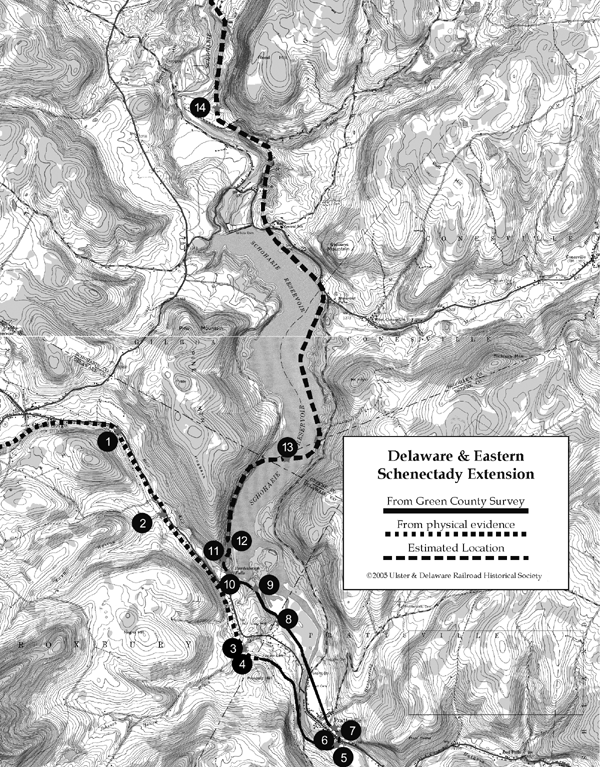 |
| 1. Probable Field Evidence: Grade visible on hillside most of the way from U&D Grand Gorge Station area to Johnson Hollow Road from Route 23. 2. Probable Field Evidence: Dry laid bridge abutment visible alongside Route 23 (current highway occupies former grade just west of this site). 3. Field Evidence: A 20 foot wide concrete highway overpass over Johnson Hollow Road (removed 1988). 4. Calculated location: There was to be a 112 foot wide culvert and fill across Johnson Hollow Brook. 5. Possible Field Evidence: Fill leading to abutment location on south bank of river across from Pratt’s Rock. 6. Calculated location: Depot was to be on Washington Street. 7. Probable Field Evidence: Grades visible from roads on both sides of Schoharie Creek in Prattsville, and fill can be seen across many backyards in the village. 8. Probable Field Evidence: 50 foot deep cut through Clay Hill (partially excavated). 9. Probable Field Evidence: Grade visible. 10. Possible Field Evidence: Possible railroad abutment (which would provide tunnel’s south portal alignment). 11. Calculated location: 900 foot tunnel about a mile below Blenheim (Horton). 12. Calculated location: Short curved tunnel through shoulder of Pine Mountain to avoid 210 degree curve to north. Probably would have been almost a reverse curve! 13. Probable Field Evidence: North tunnel portal calculated location — grading evident at location with appropriate elevation and attitude. 14. Calculated location: Trestle that was to outshine Lyonbrook, Cadosia, and Liberty trestles on the NYO&W was to have been built at Grand Gorge (Horton). Geographically, this is Grand Gorge and there is no place closer to Grand Gorge where a large trestle makes sense based on other evidence. Trestle here would have been approximately 60 feet high and almost as wide as the reservoir is today. |
Ironically, the first receivership was a generally profitable period for the railroad. After World War I, more financial troubles again forced the railroad back into bankruptcy court with new receivers appointed in 1921. Dramatic action had to be taken to stem the flow of red ink. Wages were cut and station agents eliminated. The marginal Andes Branch, the newest part of the railroad, was closed down in March 1925 after only 18 years of operation. In 1926, to reduce passenger train costs, the railroad purchased a gasoline-propelled coach from the Brill Company (noted primarily as a trolley car manufacturer) to provide passenger, mail, and express service. The car quickly acquired the sobriquet The Red Heifer because of its dull red color and its galumphing motion on the railroad’s irregularly maintained track.
The bankrupt railroad was purchased in 1929 by Sam Rosoff, a NYC subway contractor who had bought the railroad in speculative anticipation of the construction of the Pepacton Reservoir. Rosoff saw dollar signs with his Catskill railroad hauling materials for the third great Catskill reservoir.
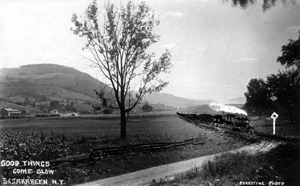 | 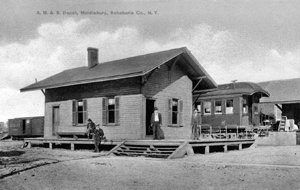 |
| Faint traces of railroad grading exist parallel to Route 30 in Breakabeen. A photographer named Bearstyne, believed to have been active in Schoharie and Delaware counties, made this faked view of a D&E coal train many decades before the word Photoshop became synonymous with altered photographs. (Richard F. Makse Collection) | Middleburgh’s sleepy depot was slated to be on the route of the Delaware & Eastern’s Schenectady Extension. The building still exists on Maple Avenue as a private house. (Richard F. Makse Collection) |
His investment, however, didn’t pan out, as the Depression and World War II delayed the construction of Pepacton. After much negotiation, the railroad between Downsville and Arkville was sold to New York City for the reservoir and Rosoff covered some of his losses through the sale of the railroad’s iron to support the war effort. The Delaware & Northern became another legend of the East Branch valley on October 17, 1942 when the Red Heifer snorted down the tracks for the last time.
Richard F. Makse has been in railroading for 41 years, retiring from the Long Island Rail Road in 1997. An independent consultant specializing in schedule development and computer simulations of railroads, Dick has served as webmaster, editor, and secretary/treasurer of the Ulster & Delaware Railroad Historical Society for the past ten years. He resides in New Jersey.
High resolution art.To use this article in your newsletter or as a handout, click into the article; select all; copy; and paste into a MSWord file.
Please remember to let us know of this use so that we can let the author or other interested parties know.
To subscribe or unsubscribe to this site, click here and select northerncatskillhistory (top left link).
Fill in your email address, name (optional), and a simple password.
You will receive an email confirming your intent
Respond to it to subscribe or unsubscribe to northerncatskillhistory.com
November 13, 2010
Copyright © 2009
northerncatskillshistory.com
contact northerncatskillshistory.com
![]()